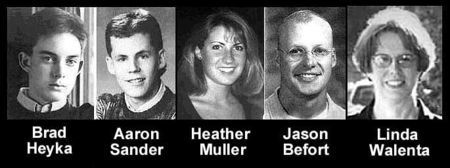


01/10/2001
Scott McConnell writes every other week in Taki’s Top Drawer/NY Press
The news reached me over New Year’s weekend. A horrible murder took place in Wichita, KS, 10 days before Christmas. It had received virtually no coverage beyond the local news.
The victims–three men and two women, white and in their 20s–were gathered in a home in a middle-class neighborhood. Two were teachers; two were engaged; one intended to become a priest. At 11 in the evening, two black men, Reginald Carr, recently released from prison, and his younger brother Jonathan, allegedly forced their way into the house, abducted the five at gunpoint, drove them around in two cars, forcing them to withdraw money from ATMs. Then they took the victims to a soccer field and forced them to kneel in the snow. They undressed the women, and raped one or perhaps both of them. Then they shot all five execution-style in the head. Four died, but one woman lived. Bleeding from her wound, she ran naked through the snow for a mile, miraculously reaching a house where she got help. The suspects were arrested the next day.
Wichita is shaken and mourning. A thousand people turned out for the funeral of one victim, Jason Befort. Rev. James Dieker, celebrant at the funeral Mass, told those gathered to look not for vengeance, but to the wisdom of Jesus on the cross: "Forgive them, Father, for they know not what to do."
Assuming that the criminal justice system will do its duty, those words may be the right ones. Yet in the current national context–with a divisive confirmation hearing looming for John Ashcroft and leading Democrats littering the airwaves with incendiary charges about the racist Republican heartland–some questions about the (non)reporting of the murder need airing as well.
If Michael McDermott’s shooting of seven in their Wakefield, MA, office on the day after Christmas deserves front-page treatment, or if James Byrd being dragged to his death by three white attackers should become a symbol of national shame, why don’t Americans know about Wichita?
They don’t because the victims were white, the suspects black. National news editors prefer a different script. Despite the raw drama of the story–the killers might still be at large were it not for the heroic effort of a woman raped, shot and left for dead in the snow–it doesn’t conform. What does fit are stories like the Byrd murder: since he was hideously dragged to death by three white men in 1998 The New York Times alone has made references to his killing in 102 separate stories, most published before the NAACP spent millions on a national campaign to boost black voter turnout by linking George W. Bush to the crime.
Occasionally facts are invented to fit the script. Several years ago, America’s evening news viewers were inundated for months with stories about an epidemic of burnings of black churches–carried out, it was charged, by racist whites. A federal investigation eventually concluded there was no racist conspiracy behind the church fires, indeed no epidemic of arson at all: just a normal rate of fires, some in white churches, some in black, some set in insurance scams, some as pranks, some because the arsonist wanted to become a hero by reporting a fire he had himself set.
But a few civil rights and anti-hate "watchdog" groups hyped stories of the black-church arson epidemic, probably for their own fundraising purposes, and the press lapped it up.
If asked, many editors would claim that one sort of crime (a racially motivated killing like James Byrd’s) deserves substantial coverage because it is a "hate crime," while the murder of four Wichita young people is not. The distinction is both false and pernicious. First, though no bias crime investigation is under way in Wichita, there is no reason whatever to think that a murder involving so much gratuitous and symbolic humiliation of the victims (forcing one to watch the rape of his fiancee in his last moments) is not motivated by "hate." Indeed, what might a thorough hate crime investigation turn up? Could the suspects have been stirred to anger against whites, for instance, by Jesse Jackson’s overheated charges that vicious racism was at work in the Florida election?
The hate-crime rubric itself is a blueprint for corrosive double standards. In law, it requires classifying crimes purportedly motivated by certain kinds of "bias" as more grave and deserving of serious punishment than others. The dual standard at once weakens a force that could unite Americans of all races and cultures (horror at crime) and threatens to transform the criminal justice system into an arena for exacerbating the country’s fault lines of race and ethnicity.
I suspect some promoting the dual standard feel virtuous and progressive–that they are advancing the multiculturalist cause by hyping news of crime of one sort and suppressing another. Some might see whites, and particularly the sort of straight, normal heartland Middle American types, as obstacles to desired social change and not deserving of very much sympathy. Others simply adapt to prevailing newsroom expectations, internalizing the double standards. Either way it’s a shameful spectacle, which does no honor to American journalism.
January 10, 2001